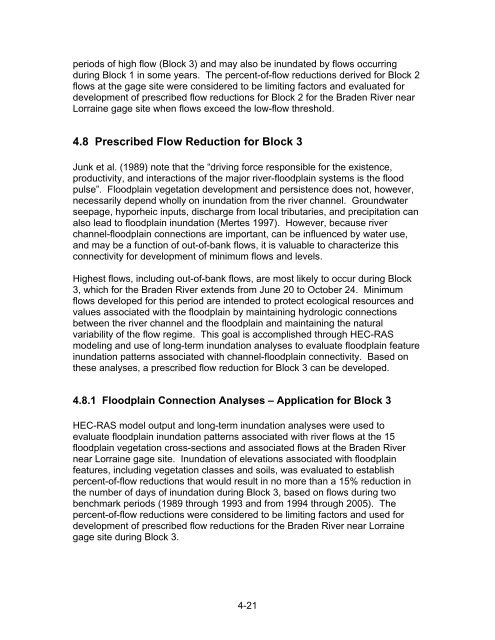Chapter 1 Minimum Flows and Levels - Southwest Florida Water ...
Chapter 1 Minimum Flows and Levels - Southwest Florida Water ...
Chapter 1 Minimum Flows and Levels - Southwest Florida Water ...
Create successful ePaper yourself
Turn your PDF publications into a flip-book with our unique Google optimized e-Paper software.
periods of high flow (Block 3) <strong>and</strong> may also be inundated by flows occurring<br />
during Block 1 in some years. The percent-of-flow reductions derived for Block 2<br />
flows at the gage site were considered to be limiting factors <strong>and</strong> evaluated for<br />
development of prescribed flow reductions for Block 2 for the Braden River near<br />
Lorraine gage site when flows exceed the low-flow threshold.<br />
4.8 Prescribed Flow Reduction for Block 3<br />
Junk et al. (1989) note that the “driving force responsible for the existence,<br />
productivity, <strong>and</strong> interactions of the major river-floodplain systems is the flood<br />
pulse”. Floodplain vegetation development <strong>and</strong> persistence does not, however,<br />
necessarily depend wholly on inundation from the river channel. Groundwater<br />
seepage, hyporheic inputs, discharge from local tributaries, <strong>and</strong> precipitation can<br />
also lead to floodplain inundation (Mertes 1997). However, because river<br />
channel-floodplain connections are important, can be influenced by water use,<br />
<strong>and</strong> may be a function of out-of-bank flows, it is valuable to characterize this<br />
connectivity for development of minimum flows <strong>and</strong> levels.<br />
Highest flows, including out-of-bank flows, are most likely to occur during Block<br />
3, which for the Braden River extends from June 20 to October 24. <strong>Minimum</strong><br />
flows developed for this period are intended to protect ecological resources <strong>and</strong><br />
values associated with the floodplain by maintaining hydrologic connections<br />
between the river channel <strong>and</strong> the floodplain <strong>and</strong> maintaining the natural<br />
variability of the flow regime. This goal is accomplished through HEC-RAS<br />
modeling <strong>and</strong> use of long-term inundation analyses to evaluate floodplain feature<br />
inundation patterns associated with channel-floodplain connectivity. Based on<br />
these analyses, a prescribed flow reduction for Block 3 can be developed.<br />
4.8.1 Floodplain Connection Analyses – Application for Block 3<br />
HEC-RAS model output <strong>and</strong> long-term inundation analyses were used to<br />
evaluate floodplain inundation patterns associated with river flows at the 15<br />
floodplain vegetation cross-sections <strong>and</strong> associated flows at the Braden River<br />
near Lorraine gage site. Inundation of elevations associated with floodplain<br />
features, including vegetation classes <strong>and</strong> soils, was evaluated to establish<br />
percent-of-flow reductions that would result in no more than a 15% reduction in<br />
the number of days of inundation during Block 3, based on flows during two<br />
benchmark periods (1989 through 1993 <strong>and</strong> from 1994 through 2005). The<br />
percent-of-flow reductions were considered to be limiting factors <strong>and</strong> used for<br />
development of prescribed flow reductions for the Braden River near Lorraine<br />
gage site during Block 3.<br />
4-21
















